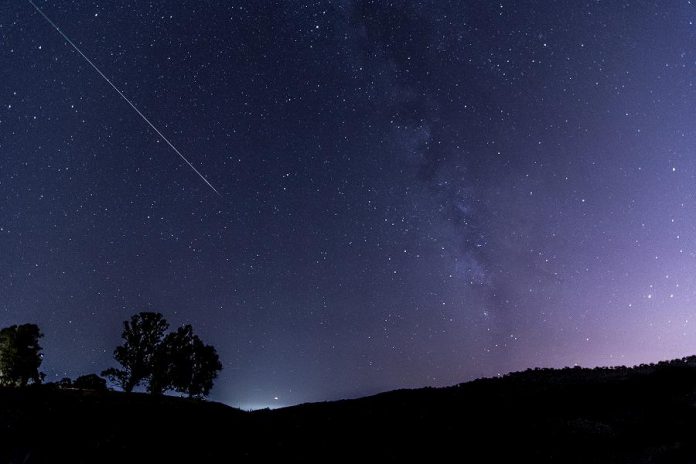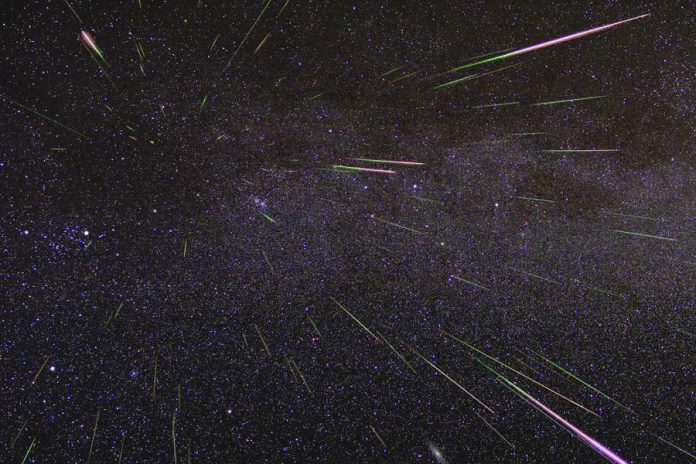
Astronomers say 2016 will be an exceptional year for viewing the annual Perseid meteor shower this month, with an “outburst” of the meteors — between 150 and 200 per hour, double the usual rate — expected overnight on Thursday, August 11th and Friday, August 12th.
Every year from late July to early August, Earth plows through the interplanetary debris left behind by comet Swift-Tuttle when it passed close to Earth (the last time was in 1992). When the particles of debris — which can be as small as a grain of sand or as big as a pea — slam into the Earth’s atmosphere at around 210,000 kilometres per hour, they heat up to 1,650 degrees Celsius and are vapourized in a burst of heat and light, resulting in a “shooting star.”
The Earth goes through the densest area of the comet’s debris field between midnight and sunrise on Friday, August 12, which is when astronomers expect the meteor outburst to happen. In Peterborough and The Kawarthas, the best time to see them is after 1 a.m. on Friday morning (after the moon has set) up until the pre-dawn hours.
The meteors are called the Perseids because they appear to originate from the northeast sky in the direction of the constellation of Perseus.
The ability to see the meteor shower peak depends on whether the skies remain clear. As of the date of this story, cloudy periods are expected overnight on Thursday and Friday. However, if if skies are cloudy during the peak of the shower this week, you can continue to see the meteors until August 26th.

If you live in Peterborough and can’t get out of the city to view the peak of the meteor shower, you can join the Peterborough Astronomical Association at 8:30 p.m. on Friday, August 12th until the wee hours of Saturday morning on top of Armour Hill at Asburnham Memorial Park.
The event is free and open to the public, with parking available in the lower lot opposite the Peterborough Museum and Archives (for safety reasons, Armour Hill itself will be closed to vehicles). While optical aids aren’t needed to see the Perseids, the association will also have telescopes set up to view other wonders of the night sky, weather permitting. Note that if the skies are too cloudy or if it’s raining, the event will be cancelled.
If you take any photos or video of the meteor shower, please share them with us at editor@kawarthanow.com, or on our social media channels (Facebook, Instagram, or Twitter).
Tips for viewing the Perseid meteor shower
- Find the darkest place you can, away from any light pollution, with as much open sky as possible. Rural areas away from city lights with few buildings or trees are the best. If you can’t get away from your city, find a park or golf course.
- Lie on your back and take in as much of the night sky as possible. You don’t have to face Perseus (to the northeast) to see the meteor shower, but the more sky you can see, the better your chances.
- Be prepared to stay outside for at least an hour. It takes 20-30 minutes for your eyes to adjust to the darkness, and the meteors come in spurts and lulls; so the longer you wait, the more you’ll see. If the outburst happens as expected, there’ll be an average of two to three meteors per minute. Some of these will be faint and some will be bright streaks.
- Stay awake. The Perseids are typically best between midnight and dawn, with the hours before dawn being the best time. During the peak night, the early morning of August 12th, wait until the moon sets at 1 a.m.
- Watch online! If you can’t get to a good location to view the meteor shower, or if skies are cloudy, you can view the shower online. Slooh.com will have a live stream starting at 8 p.m. on Thursday, August 11th, and NASA will broadcast the meteor shower live via Ustream overnight on August 11th and 12th and August 12th and 13th, beginning at 10 p.m.


























